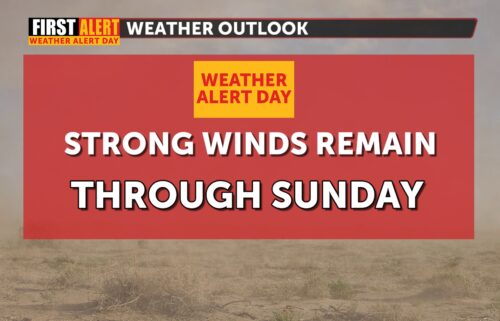School districts in the valley make modifications to outdoor activities during extreme heat
During times of High Heat, the Palm Springs School District has a plan for all staff and students when creating outdoor physical activity. Activities like recess, physical education classes, field trips, fine outdoor art, and athletic practices and competitions are all considered when creating instruction when heat warnings are implemented.
"Drinking water will be easily accessible during periods of outdoor activity," says PSUSD officials.
- The District Office will communicate activity limitations to the Principal
- Each school shall determine a Heat Advisory Communication protocol for the site.
- Coaches, Employees, and other activity staff shall inform the site regarding activities for that day for directions. • Students participating in athletics are managed using California Interscholastic Federation (CIF) guidelines about Heat illness prevention.
PSUSD Tips for Preventing Heat-Related Illness
Some health conditions can make it harder for the body to stay cool in hot weather. These include old age, obesity, fever, dehydration, heart disease, poor circulation, sunburn and drug and alcohol use. To protect your health when temperatures are very high:
Get Plenty to Drink
Sweating removes needed salt and minerals from the body. When it is hot, drink more water, juice, and sports drinks. Avoid drinks with caffeine (tea, coffee, and cola) and alcohol. Be sure to eat regularly.
Stay Cool Indoors
The best way to beat the heat is to stay in an air-conditioned area. If you do not have an air-conditioner, go to a shopping mall or public building for a few hours. A cool shower or bath is also a good way to cool off.
Wear Light Clothing and Sunscreen
Wear as little clothing as possible when you are at home. Choose lightweight, light-colored, loose-fitting clothing. In the hot sun, a wide-brimmed hat will keep the head cool. If you will be in direct sun, use sunscreen with a sun protection factor (SPF) of 15or higher and follow package directions. Reapply every 2 hours while in the sun.
Schedule Outdoor ActivitiesCarefully
Try to be less active during the hottest part of the day, late afternoon. If you must be out in the heat, plan your activities so that you are outdoors either before noon or in the evening. While outdoors, rest often in a shady area. Never leave kids or pets in a parked car.
Pace Yourself
If you are not used to working or exercising in hot weather, start slowly and pick up the pace gradually. Take frequent, regularly scheduled breaks. If activity in the heat makes your heart pound or leaves you gasping for breath, stop activity, get into a cool or shady area, and rest. Especially if you become lightheaded, confused, weak or feel faint.
Use a Buddy System
During a heat wave, check on your friends and family and have someone do the same for you. If you know someone who is elderly or has a health condition, check on them twice a day.
Cooling down techniques to prevent Heat Stroke
Immediately cool down by whatever means possible. Including an ice bath in a "cool pool" (holding head out of water). Ice packs over as much of the body as possible. A cool shower, cool wet towels, and water spray.
Tips for Treating Heat-Related Illness
Heat Stroke
Heat stroke happens when the body can no longer control its temperature. The body's temperature rises fast. The body cannot sweat and is unable to cool itself. Warning signs include red, hot, dry skin, very high body temperature, dizziness, nausea, confusion, strange behavior or unconsciousness, rapid pulse, or throbbing headache. Heat stroke can cause death or disability if treatment is not given. What to do:•
Get medical help quickly.
Get the victim to a shady area.
Cool the person off with a cool shower, garden hose, etc.
Do not give the victim fluids to drink.
If emergency medical personnel are delayed, call the hospital for further instructions.
• • • •
Heat Exhaustion
Heat exhaustion is a milder illness that happens when the body has lost too much water and salt in sweat. Warning signs include heavy sweating, cramps, headache, nausea or vomiting, tiredness, weakness, dizziness, and fainting. If heat exhaustion is not treated, it can turn into heat stroke. Get medical help if the symptoms are severe or if the victim has heart problems or high blood pressure. Help the victim cool off:
• Cool, nonalcoholic beverages
• Rest, lying down
• Cool shower, bath, or sponge bath • Air-conditioning
• Lightweight clothing
Heat Cramps
Heat cramps are muscle pains and spasms due to heavy activity. They usually involve the stomach muscles or the legs. If you have heart problems or are on a low-sodium diet, get medical attention for heat cramps. What to do:
• Stop. Sit quietly in a cool place.
• Drink clear juice or a sports beverage.
• Rest for a few hours to avoid heat exhaustion or heat stroke. • Get medical help if heat cramps do not stop after one hour.
Sunburn
Sunburn is when skin becomes red, painful, and unusually warm after being in the sun. What to do:
- See a doctor if the sunburn affects an infant younger than one year old or if there is fever, blisters, or severe pain. Do not break blisters.
- Stay out of the sun.
- Bathe the sunburned area with coolwater.
- Use moisturizing lotion on sunburn; do not use salve, butter, or ointment. •




